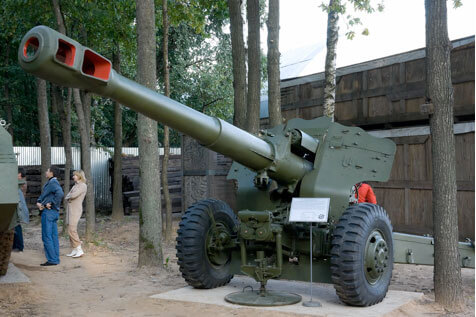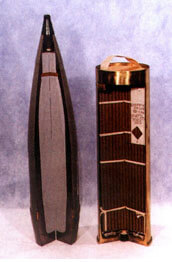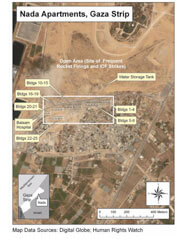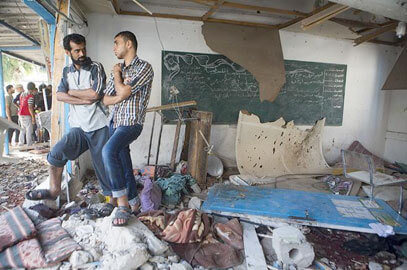Introduction
This study examines the characteristics, use and effects of heavy artillery. It is part of a series of technical studies on explosive weapons undertaken by the GICHD, providing evidence and contributing to the analysis of the final report on Characterisation of Explosive Weapons (GICHD, 2017).

Photo 1. A boy examines a house damaged by an artillery attack (photo credit: Reuters).
Artillery guns are designed to provide fire support for armour and infantry forces by firing munitions at greater distances than small arms and light weapons. In this report, the term ‘artillery gun’ is used to refer specifically to self-propelled, towed, and emplaced guns (i.e. not man-portable) of a calibre greater than 57 mm which are designed for indirect fire and capable of hitting targets at a considerable range (Ferguson et al., 2015). Artillery guns typically operate as a unit, or ‘battery’, and are intended to deliver salvo fire against an area target. Artillery guns can either be towed or self-propelled, and can be armoured or unarmoured. Modern artillery systems primarily exist to deliver ‘indirect fire’ onto targets (Dullum et al., 2016).
Artillery guns in 152 mm or 155 mm calibres can be found in the majority of current and recent conflicts that involve at least one regular army, and many that involve primarily non-state actors. The former Warsaw Pact nations selected guns chambered for the 152 mm calibre developed in Russia, while NATO members and other ‘western’ forces chose to adopt the 155 mm calibre, originally developed in France (REF). The two calibres are broadly similar in capabilities; both are able to deliver a projectile of approximately 40 kg to ranges of 17-40 km. 152 mm and 155 mm calibre guns are often considered to be ‘heavy artillery’.
152 mm and 155 mm artillery guns form a staple in nearly all state armed forces of moderate size or larger. Non-state actors such as the Liberation Tigers of Tamil Eelam (LTTE) in Sri Lanka and the Islamic State of Iraq and the Levant (ISIL) in Iraq and Syria, have successfully captured artillery guns from conventional military forces and employed these in support of their own aims. ISIL is reported to have captured 52 of the 155 mm towed artillery systems provided by the US military to the Iraqi Army, although some of these have since been recaptured by Kurdish forces or destroyed by coalition air strikes (Ernst, 2014).
152 mm & 155 mm Heavy Artillery Weapon Systems
D-20 GUN-HOWITZER

Photo 2. A D-20 artillery gun (photo credit: Dmitri A. Mottl).
One of the most prevalent towed 152 mm artillery pieces is the Soviet-designed M1955 (D-20) gun-howitzer. Copies, variants, and derivatives of this weapon are currently in service in at least 38 different countries throughout the world (IISS, 2016). In addition to the Soviet Union, copies or derivatives have been manufactured by the People’s Republic of China, Romania, the Former Republic of Yugoslavia and the People’s Republic of North Korea. The D-20 remains in use in a large number of current and recent conflicts.
2S3 AKATSIYA SELF-PROPELLED GUN

Photo 3. 2S3 Akatsiya self-propelled artillery gun (photo credit: www.rg.ru).
The 2S3 Akatsiya (‘Acacia’) is a Soviet-designed self-propelled gun that was first developed in the late 1960s, and entered into service with the Soviet Army in 1971 (Shirokorad, 1996). It is currently in service with eighteen countries (IISS, XXXX). The main armament is derived from the D-20 towed artillery gun, which has been modified and designated the D-22. In an indication of just how closely related the 152 and 155 mm designs are, a 155 mm version of the 2S3 was introduced in 2000 (Karpenko, 2009). Owing to the similarity in the design of the weapons, the towed D20 and the 2S3 have the same 17,230 m range. There have been three upgrades throughout the life of this weapon system, the most important of which is the 2S3M1, introduced into service in 1975-1987. All 2S3 weapon systems in Russian service have now been retrofitted with this upgrade (Karpenko, 2009).
There are records of the 2S3 being used in at least nine conflicts; in 2015, it was used in several countries, including Libya, Syria and Ukraine (ARES, 2016).
2S19 MSTA-S 152 MM SELF-PROPELLED HOWITZER

Photo 4. 2S19 Msta-S self-propelled artillery gun (photo credit: Parade @ Kiev ).
The 2S19 is the self-propelled version of the towed 2A65 Msta-B artillery gun. These systems were designed in parallel in the late 1970s to early 1980s, with the Msta-S entering service with the Soviet Army in 1989. It is currently in service with the militaries of eight countries (IISS, 2016). Like the 2S3 before it, the 2S19 can also be fitted with a 155 mm gun for export orders. The 2S19 can fire all 152 mm ammunition and the Krasnopol and Krasnapol-M PGMs.
LW155 155 MM ULTRALIGHTWEIGHT FIELD HOWITZER

Photo 5. Photograph of the LW155 (photo credit: Specialist Evan D. Marcy, U.S. Army).
The LW155 is a British-built, towed artillery system that is currently in service with the U.S. Army, the U.S. Marine Corps (as the M777), the Canadian Armed Forces, and the Australian Army. It has been used in Afghanistan and Iraq, and has a maximum range of 24 km with unassisted rounds, and 30.5 km when firing rocket-assisted rounds (Gourley, 2012). This weapon system is fitted with a digital fire control system and can fire the Excalibur (a GPS/inertial navigation guided projectile). When firing the Excalibur, the maximum range is 40,000 m with a Circular Error Probable (CEP) of less than 4 m (Milner, 2012).
HIGH EXPLOSIVE ARTILLERY AMMUNITION - OVERVIEW
High explosive (HE) artillery ammunition consists of a projectile, propellant and fuze, and sometimes of several other components which may or may not be present in a given design. The projectile is made up of a high explosive charge packed into a thick casing, typically constructed of hardened steel. The steel body serves two functions: firstly, it ensures that the ammunition is robust enough to withstand the intense forces it is subjected to during firing and whilst in flight; secondly, when the explosive fill detonates, it provides the primary fragmentation effect. Different types of projectile bodies use different types of steel alloys. The more modern projectiles tend to use steel that has not been heat-treated, because it has been found that this type of steel shatters into smaller and more regular fragments than other types of steel, thus increasing the lethal area of the projectile for the same weight of ammunition.
Similar to a bullet being fired from a rifle, artillery projectiles are spinning at a very high speed when they exit the barrel of the gun. The spinning stabilises the projectile in flight and makes it more accurate. Artillery guns are typically rifled, with spiral grooves running the length of the barrel; the raised counterparts to these grooves are known as ‘lands’.

Figure 1. Cross-section of a rifled barrel. ‘X’ marks the lands, whilst ‘Y’ marks the grooves (source: ARES).
Each projectile is fitted with a fuze, either at the time of manufacture or, more commonly, prior to firing. The fuze must serve three functions: 1) ensuring a munition can be safely handled during the loading process and in transit; 2) arming the munition at a given time or position; and 3) ensuring the munition functions at a given time or position (Dullum et al. 2016; King, 2011). HE projectiles are most often fitted with impact fuzes, but may occasionally be fitted with a proximity fuze that functions the munition at a pre-determined distance from the target. For more on fuzing, see the relevant section in the Final Report.

Photo 6. Parts of an artillery projectile (photo credit: Yugoimport).
Most ammunition for artillery systems can be described as fixed, semi-fixed, or separate loading. In fixed ammunition, the propellant charge is entirely contained within the cartridge, with the cartridge case affixed to the projectile. The majority of ammunition fired by artillery systems is either semi-fixed or separate loading. Semi-fixed ammunition is separated into two groups of components: the projectile and fuze; and the cartridge case, primer, and one or more propellant charges. Separate-loading ammunition consists of a fuzed or unfuzed projectile, a primer, and one or more propellant charges (Dullum et al., 2016).
Semi-fixed and separate-loading ammunition both require a minimum of one propellant charge to fire the projectile, which is often supplemented by further propellant increments. Increments are combined to achieve the desired muzzle velocity for a given gun barrel elevation. This allows the artillery unit commander, in accordance with standard procedure, to vary the quantity of propellant used to fire some projectiles, and hence the range of the system (Dullum et al., 2016; US Army, 1994; US Army, 1999).

Photo 7. An example of Russian semi-fixed ammunition, with the projectile on the left and the propelling cartridge on the right (photo credit: VTTV-Omsk).
There are numerous types of HE and high explosive fragmentation (HE-FRAG) projectiles available in the 152 mm and 155 mm calibres. The two calibres are so similar that several manufacturers produce near-identical HE projectiles in both calibres. Some of the common types of projectile can be further grouped into sub classifications.
- Conventional HE projectile
- Base-bleed projectile
- Rocket-assisted projectile (RAP)
- Precision-guided projectile.
Conventional projectiles are fired from the gun and rely wholly on the energy imparted by the propelling charge or propelling cartridge to reach their target. Base-bleed projectiles are similar to conventional projectiles in that they also rely wholly on the energy imparted by the propelling charge or propelling cartridge to reach their target. However, base-bleed projectiles have a longer range than conventional projectiles owing to a small burning charge in the rear. When this charge slowly burns, the gases produce bleed into the aerodynamic wake of the projectile, reducing the drag caused by the low-pressure area at the rear. This can increase the range of the projectile by 30% over that of a conventional projectile (Reid, 2014).
Rocket-assisted projectiles contain a small rocket motor in the rear. Shortly after leaving the gun barrel, the rocket motor will ignite and provide additional thrust to the projectile. This means that the projectile is travelling at a higher velocity, and therefore has a longer range, than a conventional projectile.
Base-bleed and rocket-assisted projectiles are typically longer than conventional projectiles, to incorporate the burning charge and the rocket motor respectively. In some cases, munitions may feature a combination of auxiliary propulsion methods, such as a combined base-bleed and rocket motor approach. The use of projectiles with auxiliary propulsion methods, and of RAP munitions in particular, may result in additional collateral damage concerns. Should a RAP rocket motor fail to ignite, for example, projectiles may fall as much as several kilometres short of the target area (US Army, 1991b).
Precision-guided projectiles for artillery are not common due to associated high development costs and existing doctrines which do not consider artillery use as a precision weapon. However, this is increasingly changing with introduction of bolt-on guidance kits to convert existing munitions into guided equivalents. For example, the U.S. military has introduced the XM1156 Precision Guidance Kit (PGK); a replacement fuze with course correction capability to significantly reduce the CEP of conventional 155 mm artillery munitions to 50 m (or less) at all ranges. The cost of the XM1156 is less than US$ 10,000 (Gould, 2015).
HEAVY ARTILLERY CASE STUDIES
More than 20 cases were studied where artillery guns of 152 and 155 mm calibres were involved. 5 case studies were selected for this report on the basis of the confirmed use of these weapons, the accuracy of documentation, and to geographical distribution of conflicts across the weapon studies. These cover the period from April 1996 to July 2014 and the following countries and territories: Lebanon, Palestine and Syria.

Table 1. – Case Studies for 152-155 mm Artillery
BRIEF DESCRIPTIONS
Case Study No 1
Qana, Lebanon, 18 April 1996
At approximately 14:00, 34 HE projectiles impacted in and around a UN Interim Force in Lebanon (UNIFIL) compound in Lebanon over a period of approximately 15 minutes. Thirteen of these projectiles impacted inside the compound, or were fitted with proximity fuses and detonated directly above it. The projectiles were fired from 155 mm weapon systems. This attack killed approximately 100 civilians, with an additional 100 reported to have been injured.
Case Study No 2
Beit Lahia, Gaza, Palestine, 9 June 2006
Between 16:31 and 16:50, eight projectiles landed in the immediate vicinity of a public beach in Beit Lahia, Gaza. Of these, six were 155 mm Artillery projectiles fired from Israel; the remaining two projectiles were fired from a warship. It has not been possible to differentiate between the two types of projectiles, although a Human Rights Watch investigation confirmed that the projectile that caused the fatalities was fired from a 155 mm weapon system. One of the projectiles killed seven members of the same family, including five children. Dozens more people were injured, many seriously. Most of the injured suffered multiple injuries.
Case Study No 3
Gaza, Palestine, 24-29 July 2006
Multiple 155 mm Artillery attacks took place between 24 and 29 July 2006. The buildings of the Nada apartment complex were repeatedly targeted, but some projectiles also hit the Balsam hospital that is located to the west of the complex. Four civilians, including two children, were killed in one of the attacks on 24 July. The later attacks are reported to have caused “dozens” of casualties, but the majority of families evacuated the complex after the first few attacks, so the number of casualties is probably lower than would otherwise be the case.
Case Study No 4
Al-Zarra bakery in Qadi Askar, Aleppo, Syria, 16 August 2012
At approximately 05:45, hundreds of people were queuing for bread outside the Al-Zarra bakery when four HE Artillery projectiles impacted the area. One of these projectiles landed on the street right outside the bakery, and it is this projectile that is believed to have caused the majority of the casualties. Another two projectiles struck an apartment building opposite the bakery. The projectiles are believed to have been 152 mm HE projectiles fired from a 2S3 Akatsiya weapon system. Local hospital records show that 60 people were killed and 79 injured in this attack, which was part of a campaign involving at least nine other reported early-morning attacks on bakeries in August 2012.
Case Study No 5
Jabaliya Girls Elementary School A & B, Gaza, Palestine, 30 July 2014
At approximately 04:40, at least ten HE Artillery projectiles began to impact the Jabaliya Girls’ Elementary School and its immediate surroundings in the Jabaliya refugee settlement, in Gaza. This school is in a densely populated area. The projectiles were 155 mm projectiles. This attack killed 21 people and wounded at least 100.
ANNEX C: CASE STUDIES
CASE STUDY 1
Date/time of attack:
18 April 1996, 14:00
Location:
UNIFIL compound and surrounding areas, Qana, southern Lebanon.
Map of the area:
See Figure 2. More detailed images of the location could not be obtained, however the UN report into the incident included a sketch of the impact of projectiles in and around the UN compound (see Figure 3). As the sketch shows, two distinct areas were hit during the shelling – the UN compound, and a group of houses about 100 m south of the compound. Neither of the areas included the location of the Hezbollah mortar, which was supposed to be the intended target (located 75 m south-east from the second impact area).
Weapon System:
M-109A2 155 mm.
Number of munitions fired:
17 projectiles in the area south of the compound, 13 inside or directly above the UN compound, and 4 close to it, altogether 34.
Estimated impact area:
“The southernmost cluster of 17 impacts in the vicinity of the mortar position fits into a square of some 150 m (along the longitudinal axis) by 55 m. The dispersion pattern of this cluster suggests it was a result of converging fire, carefully prepared in the elapsed 15 minutes. The northernmost cluster of impacts in and around the UNIFIL camp fits into a larger box of some 240 m (along the longitudinal axis) by 170 m – which could be reduced to 100 m if one concludes that the five westernmost impacts were fired by one gun, which was not carefully aligned. The centre point of impacts in this cluster of projectiles is 250 m from the centre point of the southernmost box.”
Casualties:
Over 100 civilians killed and another 100 injured.
Damage:
Unclear, but likely serious structural damage to the UN compound and the houses south of the compound.
Infrastructure damage:
Unknown.
Distance from point of detonation:
See above description of radius.
Remarks: N/A.

Figure 2. Map of the UNIFIL compound and surrounding areas, Qana, southern Lebanon (photo credit: Van Kappen, 1996).
Figure 3. Diagram indicating the impact location of projectiles in and around the UN compound (photo credit: Van Kappen, 1996)
CASE STUDY 2
Date/time of attack:
9 June 2006, approximately from 16:31-16:50.
Location:
A public beach in Beit Lahia, Gaza, Palestine.
Map of the area:
See Figure 4.
Weapon system:
M-109, 155 mm.
Number of munitions fired:
8 projectiles; 6 from across the border and 2 from a warship.
Range munition fired from:
Various.
Casualties:
7 people, including 5 children, killed and dozens injured.
Damage:
No significant damage, as the attack fell on a beach.
Infrastructure damage:
No significant damage.
Distance from point of detonation:
One of the projectiles fell 300-500 m from a family group having a picnic on the beach, another fell about 150 m away, and the fatal one between the groups of men and women of the family.
Remarks: N/A.

Figure 4. Map of Beit Lahia, Gaza, Palestine (photo credit: Digital Globe, Human Rights Watch).
CASE STUDY 3
Date/time of attack:
Multiple attacks took place between 24 and 28 July 2006. On July 24, five attacks took place: two around 13:00-13:30, one at 15:00, one around 14:00-14:30, and one at around 23:00-24:00. On July 26, continuous shelling throughout the early hours of the morning, starting about 04:30, intensifying at 06:15. On July 28, the attack took place at around 20:00.
Location:
“About a kilometre from Gaza’s northern border, on the western edge of Beit Hanoun, along a bypass road linking Gaza City with the Erez Crossing into Israel.” Shelling took place in and around the apartment complex, and also hit the surrounding area, i.e. the Balsam hospital that is located west of the complex (see Figure 5).
Map of the area:
See Figure 5.
Weapon system:
Unclear; 155 mm shells found at the scene.
Number of munitions fired:
Multiple over several attacks.
Range munition fired from:
Unclear.
Estimated impact area:
Practically the entire area of the complex was affected during the days of shelling.
Casualties:
Four civilians, including two children were killed on 24 July; dozens wounded throughout the duration of shelling.
Damage:
The apartment sustained serious structural damage, including shrapnel holes in walls and roofs and shattered windows. Several projectiles hit the buildings directly, causing significant damage, such as collapsed roofs and large tears in walls.
Infrastructure damage:
At least one shop was damaged and the front and reception area of the Balsam hospital. Roads are also presumed to have been damaged.
Distance from point of detonation:
Varied. For example, one of the children killed on 24 July was about one metre away from the impact point.
Remarks:
The shelling on the first day forced most of the residents to abandon their homes, which may have contributed to the lower number of casualties during the further attacks.
Source(s):
- Human Rights Watch (in-depth case study, see Annex II of the report): https://www.hrw.org/sites/default/files/reports/iopt0707web.pdf

Figure 5. Map of Nada Apartments, Gaza, Palestine (image credit: Digital Globe, Human Rights Watch).

Photo 8. The entrance of Building 12 of the Nada Apartments shows some of the damage caused by a 155 mm, HE Artillery projectile. This same projectile killed an 11 year old girl and seriously injured her 12 year-old sister (photo credit: Joe Stork/Human Rights Watch).
CASE STUDY 4
Date/time of attack:
16 August 2012, around 05:45.
Location:
Qadi Askar neighbourhood in Aleppo city – one projectile landed near a Free Syrian Army facility, two projectiles hit an apartment building on the other side of the street from the bakery, and one more hit the street a few metres away from the bakery where hundreds of people were queuing for bread.
Map of the area:
The approximate location of the impacted neighbourhood is shown in Figure 6 within the red box. More detailed maps were unavailable.
Weapon system:
152 mm projectiles, most likely from a 2S3 Akatsiya self-propelled Artillery system.
Number of munitions fired:
Four.
Range munition fired from:
Unclear.
Estimated impact area:
A few hundred metres.
Casualties:
No clear data, somewhere between 35 and 50 dead, although hospital records listed 60 dead and 79 injured.
Damage:
Likely significant structural damage to the apartment building, fragment damage to the bakery, possibly cars and nearby buildings, shattered glass.
Infrastructure damage:
Likely damage to the street on which the projectiles exploded, bakery.
Distance from point of detonation:
A few metres.
Remarks:
This was one of at least ten documented attacks on bakeries. In addition to clear immediate effects of such attacks, long-term effects may be much more severe, particularly in terms of food supply to the besieged civilian populations.

Figure 6. Area around the Al-Zarra bakery in Qadi Askar, Aleppo city, Syria (photo credit: Joe Stork/Human Rights Watch).
CASE STUDY 5
Date/time of attack:
30 July 2014, around 04:40.
Location:
Jabaliya refugee settlement.
Map of area:
See Figure 7. A more detailed map of the area could not be found, but from satellite imagery provided by Google, it is evident that the Jabaliya neighbourhood where the school is located is a densely built-up and populated area. A New York Times investigation into the attack described the area where the school was located as “a busy residential street dotted with ground-floor barbershops, pharmacies and groceries”. The investigation charted a map of the impact areas, as seen below.
Weapon system:
Exact model unknown, 155 mm Artillery.
Number of munitions fired:
At least ten.
Range fired from:
“Damage indicated the shells came from the northeast — where artillery units are stationed on the hills outside Gaza’s border”.
Estimated impact area:
From the NY Times image (Figure 8), the impact area seems to be about 122 m.
Casualties:
21 killed and more than 100 wounded, many of whom were women and children using the school as a shelter from continuous fighting during that period. The school, run by the UN, was thought to be a safe place. It is reported that 3,200 people were in the school at the time of the attack.
Damage:
Livestock killed.
Infrastructure damage:
Buildings damaged, roofs and walls of nearby buildings and of the school collapsed, the courtyard of the school damaged.
Distance from point of detonation:
Unknown.

Figure 7. Satellite imagery of the Jabaliya Elementary Girls School A & B, Gaza, Palestine (source: Google Maps).
Figure 8. Map of the impact areas around the Jabaliya Elementary Girls School (source: The New York Times).

